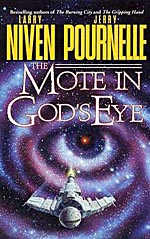
![]() attackofthebooks
attackofthebooks
3/13/2015
![]()
What happens when man finally finds sentient life on another planet, but that civilization cyclically destroys itself under overpopulation pressures cyclically?
When man finds the Moties, not only are the Moties more intelligent and technologically adept than us, but they are faster and the breed at rabbit-like speeds. Unfortunately, the breeding is necessary to stay alive, and it results in enormous resource competition on their home planet. With only limited resources, planetary war regularly and cyclically knocks the civilization back into the dark ages.
And the cycle is just about to start again when man shows up...
While The Mote in God's Eye is long past release (it was published first in 1974, predating my birth by several years), it resonates even today. I opened it at the recommendation of another reader, and I was impressed with Niven and Pournelle's description of how war or battles might occur in space. Nothing like Star Wars where battles between star ships have more in common with World War Two navies and aerial dog fights than the realities of momentum, vacuum, and weightlessness that might actually impact the outcome of a fight long distances away from the gravitational effects of a planetary body.
I also found their description of meeting intelligent life on another planet fascinatingly creative and imaginative. The idea that a civilization would rise, and fall, without any morality but survival, is fascinating. The Moties themselves are as fascinating a piece of the story as anything. With attention to science and a story that is deeper than defeating a foe, it's clear why the authors, and their books, are counted among science-fiction's classics.
http://www.attackofthebooks.com/review-the-mote-in-gods-eye-by-larry-niven-and-jerry-pournelle/